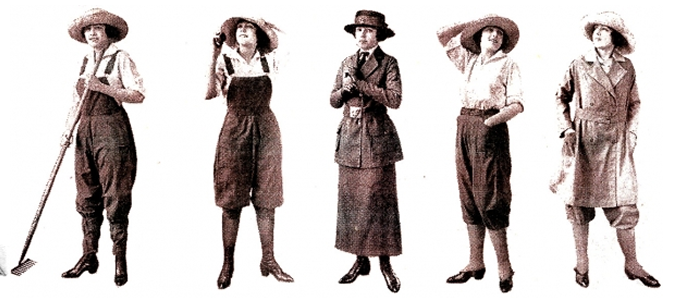Underneath the Romance: 1830s Skirt Supports
by Catherine Scholar, First published for the September/October 2008 issue of Finery The fashionable silhouette of the 1830s included a bell or dome shaped skirt, which was supported by multiple starched white cotton petticoats. This simple garment is difficult to research, as there isn’t much helpful information available, and few extant garments. In The History of Underclothes, authors Willet and […]
Hairstyles and Hats of the Edwardian Era, 1900-1915
by Kendra Van Cleave, First published for the July/August 2008 issue of Finery Hairstyles and headwear are inextricably linked in almost every era; hairstyles affect the shape and placement of the hat and vice versa. The “pompadour” popular in the 1890s belied its name. Rather than a large amount of volume, hair was dressed loosely but still simply and close […]
Dressing a Lady for Dickens Fair
by Sally Norton, First published for the November/December 2007 issue of Finery Many practical Victorian ladies had two separate bodices for many of their gowns. Both bodices would be made out of material that matched the skirt. This is the perfect solution for those of us wishing to attend an elegant tea and a Victorian ball. One bodice will have […]
Mourning Custom and Ritual
by Sally Norton, First published for the September/October 2007 issue of Finery Victorian mourning customs seem strange to us now, but they grew out of centuries of social ritual. Formal mourning was observed in England for royalty and nobles in Medieval times. As with other practices, those who could afford to copied the upper crust. The 19th century brought together […]
The Allure of Black
by Sally Norton, First published for the November/December 2006 issue of Finery Whitby Jet became extremely popular for jewelry in the 19th century. While some black jewelry was meant to be worn during mourning, black jewelry was fashionable as well, and worn for its beauty. The most prized jet is from Whitby, England where it has been washing up on […]
Fashion and Non-fashion and the Beat Generation
by Sally Norton, First published for the March/April 2006 issue of Finery The 1950s Beat Movement in San Francisco was a non-fashion moment. Clothing was of minimal importance to the San Francisco writers, poets and musicians in North Beach. Words, music and ideas mattered. Clothing was practical, necessary and of little aesthetic value. You would see people wearing ordinary, everyday […]
The Effect of World War I on American Fashion
by Kendra Van Cleave, First published for the March/April 2005 issue of Finery By 1913, the characteristic Edwardian female silhouette, with its tightly corseted body and long skirts, had given way to a straight, high-waisted look that was thought to be more “natural” than previous styles. As the decade progressed, women’s fashions grew less restrictive, and flared skirts, loose jackets, and […]
Notes on the Chinese Cheung Sam
by Mercurio Ekaterin, First published for the November/December 2004 issue of Finery Although often thought of as a quintessentially traditional Chinese garment, the Cheung Sam (aka Qi Pao) is primarily a 20th-century evolution from the Manchurian banner gown. At the turn of the century, the two-piece, loose-fitting shirt and trousers/skirt combination was still common alongside the one-piece banner gown. The […]
Pretty Prints, Clever Cottons: 18th·Century Fabrics
by Kendra Van Cleave, First published for the March/April 2004 issue of Finery Many of you may be thinking about creating new garments for the Travelers in Tuscany event on June 5th at Viansa Winery. While silk, wool, and linen were the most plentiful fabrics during the eighteenth century, today cotton is cheap, easy to find, and comfortable for a summer […]
Gibson Girls on the Loose
by Anonymous, First published for the March/April 2004 issue of Finery Will you be a graceful Edwardian lady in a lavishly trimmed white gown or a sporty Gibson Girl in a trim shirtwaist and tailored skirt at our garden party on April 25th? Edwardian dress gives you many choices and styles to choose from. In the summer of 1899, fashion […]










